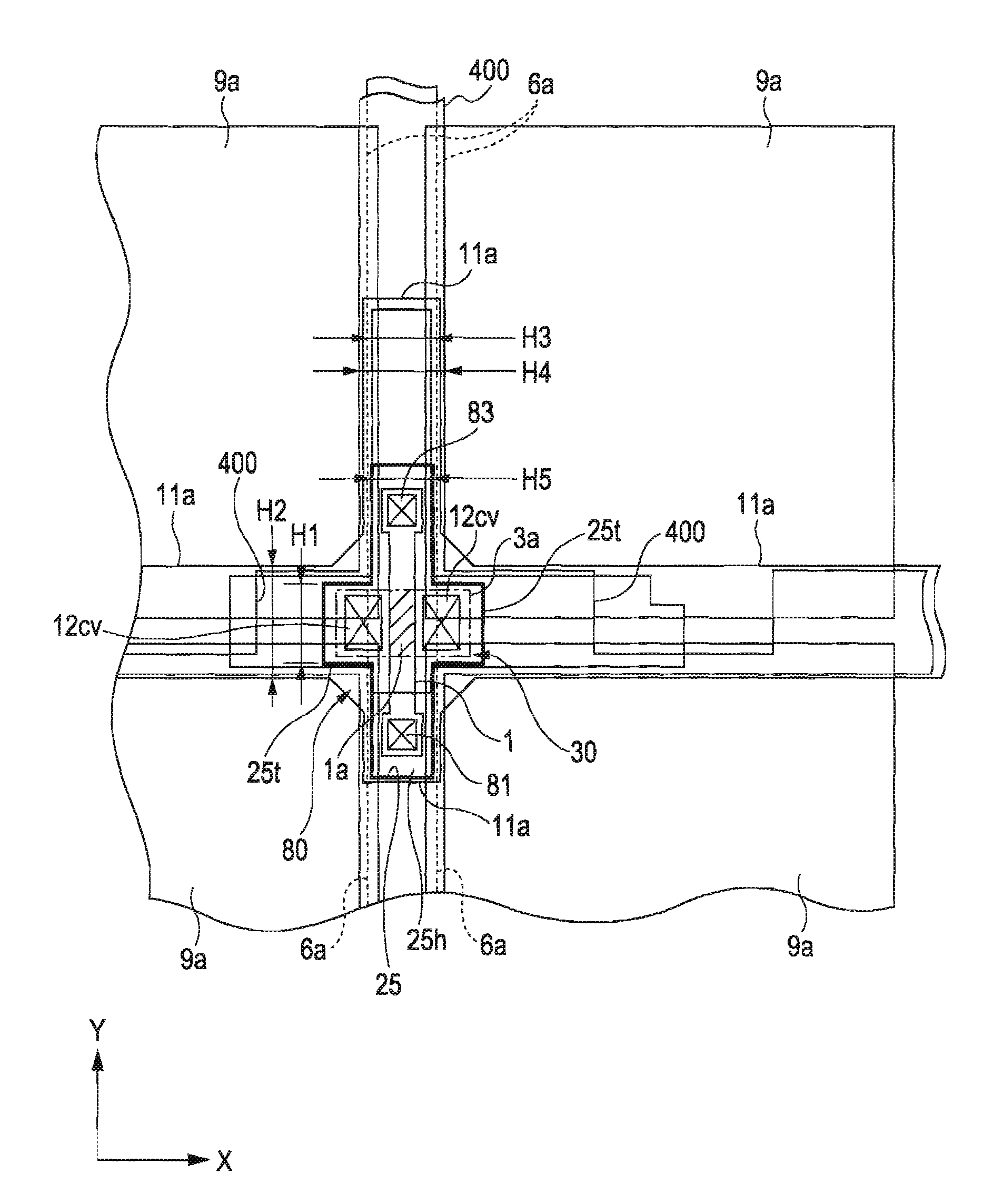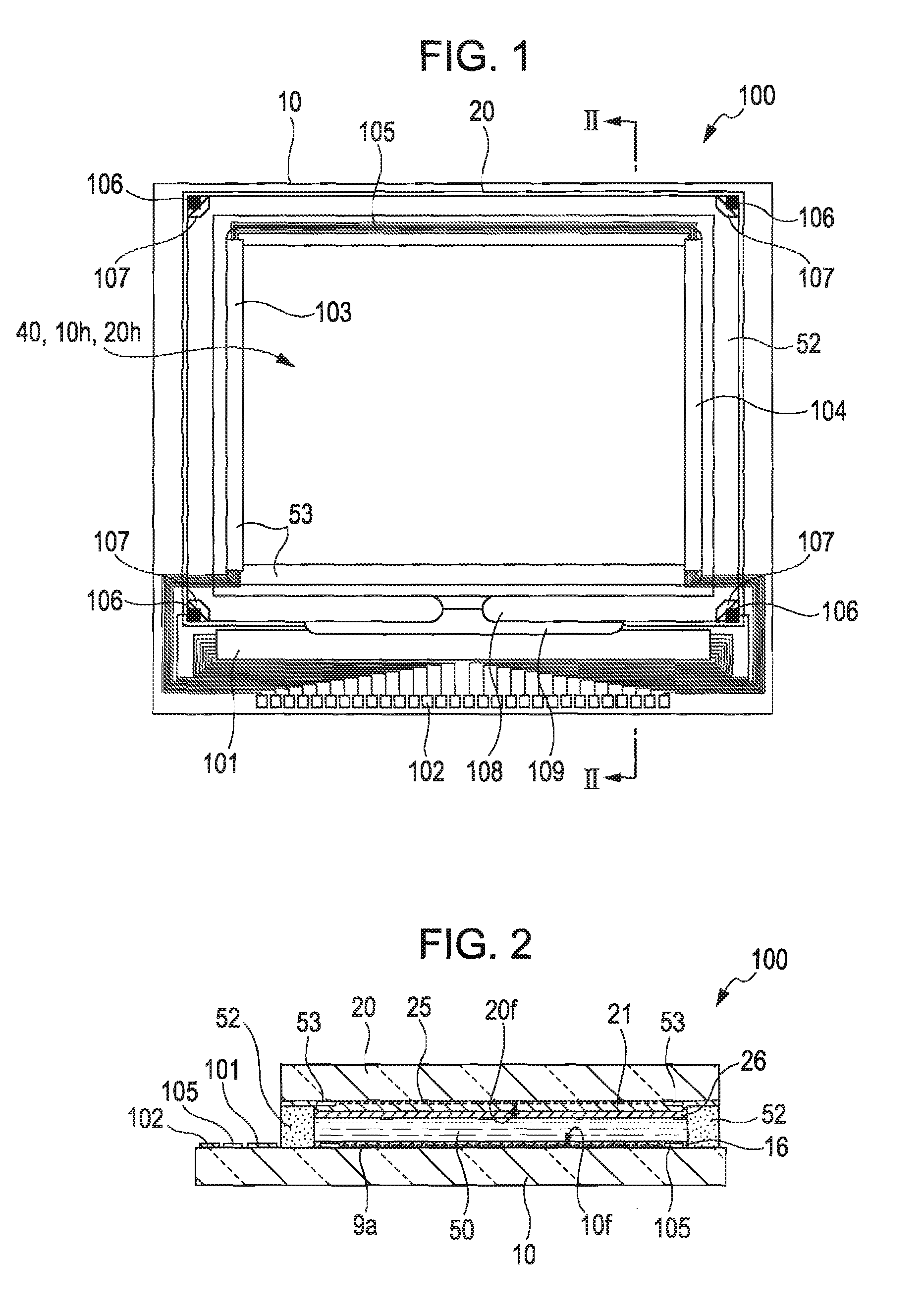Electro-optical device and electronic apparatus
a technology of optical devices and electronic devices, applied in semiconductor devices, radio frequency controlled devices, instruments, etc., can solve the problems of affecting the accuracy of the positional accuracy of the opposite substrate, so as to reduce the variation in the aperture ratio between pixels and prevent the variation of the pixel aperture ratio. , the effect of poor positional accuracy
- Summary
- Abstract
- Description
- Claims
- Application Information
AI Technical Summary
Benefits of technology
Problems solved by technology
Method used
Image
Examples
first embodiment
[0073]FIG. 1 is a plan view of a liquid crystal device according to the present embodiment. FIG. 2 is a cross-sectional view that is taken along line II-II in FIG. 1.
[0074]As shown in FIG. 1 and FIG. 2, a liquid crystal device 100, for example, includes a TFT substrate 10, an opposite substrate 20, and a liquid crystal 50. The TFT substrate 10 is formed of, for example, a crystal substrate, a glass substrate, or a silicon substrate. The opposite substrate 20 is opposed to the TFT substrate 10 and is formed of, for example, a glass substrate, a crystal substrate, or a silicon substrate. The liquid crystal 50, which is a electrooptic material, is interposed in a space between the TFT substrate 10 and the opposite substrate 20. The TFT substrate 10 and the opposite substrate 20, which are opposed to each other, are bonded by a seal material 52.
[0075]A display area 10h of the TFT substrate 10 which forms a display area 40 of the liquid crystal device 100 is formed on a surface 10f of th...
second embodiment
[0129]FIG. 7 is a partial plan view showing portion of a deposition pattern that is laminated on a TFT substrate and arrangement of one of BMs formed on an opposite substrate in a liquid crystal device according to the present embodiment.
[0130]The configuration of the liquid crystal device according to the second embodiment is only different from the liquid crystal device 100 according to the first embodiment in that the BM is formed into a rectangular shape on the opposite substrate 20. Thus, only the difference will be described, the same reference numerals are assigned to the same or similar components as those of the liquid crystal device 100 according to the first embodiment, and a description thereof is omitted.
[0131]As shown in FIG. 7, BMs 250 each are patterned in a corresponding one of the crossover regions 80 to form a rectangular island shape that at least partially overlaps the semiconductor layer 1 of the TFT 30 in plan view.
[0132]Specifically, in each of the crossover ...
third embodiment
[0147]FIG. 10 is a partial plan view showing portion of the lower layer of a deposition pattern that is laminated on a TFT substrate and arrangement of BMs formed on an opposite substrate in a liquid crystal device according to the present embodiment. FIG. 11 is a partial plan view showing portion of the upper layer of the deposition pattern that is laminated on the TFT substrate of the liquid crystal device according to the present embodiment. FIG. 12 is a cross-sectional view, taken along the line XII-XII in FIG. 10 and FIG. 11, showing the TFT substrate when the configurations shown in FIG. 10 and the configuration shown in FIG. 11 are laminated.
[0148]The configuration of the liquid crystal device according to the third embodiment is only different from the liquid crystal device 100 according to the first embodiment and the liquid crystal device according to the second embodiment in that, as viewed in plan, the shape of each scanning line and the shape of each island BM formed on...
PUM
 Login to View More
Login to View More Abstract
Description
Claims
Application Information
 Login to View More
Login to View More - R&D
- Intellectual Property
- Life Sciences
- Materials
- Tech Scout
- Unparalleled Data Quality
- Higher Quality Content
- 60% Fewer Hallucinations
Browse by: Latest US Patents, China's latest patents, Technical Efficacy Thesaurus, Application Domain, Technology Topic, Popular Technical Reports.
© 2025 PatSnap. All rights reserved.Legal|Privacy policy|Modern Slavery Act Transparency Statement|Sitemap|About US| Contact US: help@patsnap.com



